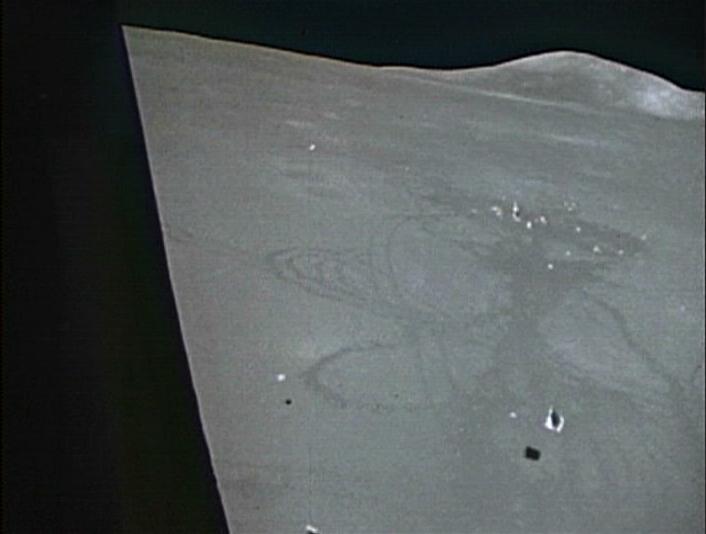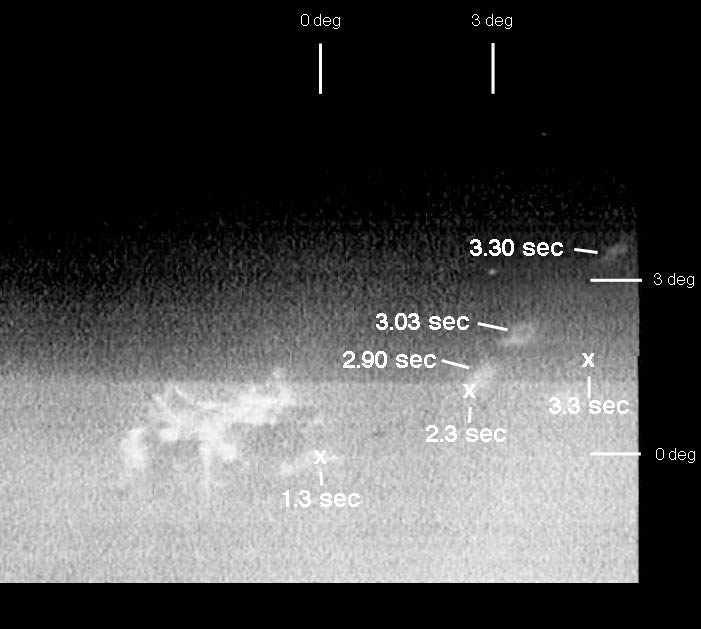
Flight of an Apollo 15 Thermal
Blanket
Copyright © 2007 by the Editors of Working on the
Moon.
Last revised 6 January 2012.

A thermal blanket is seen on the right in flight toward a
narrow
miss of the ALSEP experiments. A smaller object on the left is
headed
in the direction of the LRRR. Frame from the 16mm DAC film
taken out
the LMP's window 3.25 seconds after first ascent stage motion.
The
blanket will impact the surface about 10-12 meters north of
the Central
Station at about 6.8 seconds.
Summary
During all the Apollo LM liftoffs, the ascent engine exhaust
propelled
fragments of desent stage insulation in all directions and, in some
cases, large, lightweight objects were thrown distances of over 100
meters at velocities of about 20 meters per second before striking
the
lunar
surface and, eventually, coming to rest. A spectacular example was
an
Apollo 15 thermal blanket which took flight from the vicinity of the
MESA about 1.3 seconds after first ascent stage motion. About 5.5
seconds later, after about 110 meters of flight at an average ground
speed of 20 m/s, the blanket struck the lunar surface about 11
meters
north of the ALSEP Central Station. During the impact, it created a
short-lived dark mark† (lofted dust?) about three meters long
and
a half meter wide before bouncing/rolling farther away from the LM,
finally coming to rest about 70 meters beyond the Central Station.
Had
the blanket hit the Central Station, it seems likely that, at the
very
least, the antenna would have been knocked out of alignment with a
consequent loss of data.
Lessons
(1) During final crew activities on the surface, secure or stow
any
debris which could be a hazard to long-term experiments or
structures.
and/or
(2) Ensure that landing areas are sufficiently far from
experiment
sites and structures.† In the case of the Apollo LM, an
adequate
separation would have been something in excess of 200 m (subject
top
analysis of other liftoff films).
TV and DAC Recordings
We have two visual records of the Apollo 15 LM liftoff: the 12
frame-per-second (fps), 16mm DAC film shot out the LMP's window and
the
30 fps TV record. For convenience we can define the
start of liftoff as
the first occurrence of sustained, upward motion of the ascent
stage. Ken Glover has used the 60 fps version of the TV record on
the Spacecraft Films Apollo 15 DVD set (Disk 6) to capture 20 successive frames ending with
the first spacecraft motion.† The third and fourth frames show
a red glow at the base of the ascent stage, while the fifth shows
more extensive blue cloud in the same area. Both may be related to
stage separation.
For the purposes of the following discussion, we can call the
16-mm frame showing first sustained upward displacement
'frame16-00'.
Blanket Trajectory in the 16-mm Film
In the 16mm film, the thermal blanket is first visible at the
bottom
of
frame16-23, which is about 1.9 seconds after first spacecraft
motion.

Frame16-24 is the second of the 16-mm frames showing a
thermal
blanket flying away from the LM from the vicinity of the MESA.
This
frame was taken about 2.0 seconds after first spacecraft
motion. Just
beyond the blanket, note the edge of the continuous area of
darker,
disturbed lunar soil that is about 20 meters out from the
MESA. See,
also, pre-launch window photo AS15-88-11951.
In frame16-28 (2.33 seconds), the blanket and its shadow are seen
crossing the outer edge of the disturbed area out in front of the
LM.
This edge is about 20 meters from the MESA. If we assume that the
blanket accelerated quickly to its final speed and that its
subsequent
motion wasn't signifcantly influenced by the ascent engine exhaust,
we
can estimate that it took flight roughly 1.3 seconds after first
spacecraft motion, perhaps because, prior to that time, the blanket
was
shielded from much of the engine exhaust by the bulk of the descent
stage. At about the presumed time that the blanket took flight,
frameTV-40 in the TV record shows that the Ascent Stage had risen
about
it's own height and was accelerating rapidly upward.
Close examination of the 16mm film indicates that the blanket
impacts the surface just north of the Central Station about 6.9
seconds
after first spacecraft motion and about 5.6 seconds after the
blanket's
presumed launch from the MESA. The distance flown is about 110
meters,
giving a ground speed of about 20 m/s. The launch elevation angle,
A,
is approximated by
sin A = t g / 2 V
where t is the time of flight (5.6 seconds), g is lunar gravity
(1.62
m/s/s), and V is the ground speed (20 m/s). These values give A =
13
degrees.

Film strip of the blanket in flight. Note that the frames
are not
evenly spaced in time. Click anywhere on the strip for a
larger
version. (1) Frame16-27 (2.25 seconds) A comparison with Frame
16-24
(above) and subsequent frames in this strip shows that various
tumbling
motions were imparted to the blanket during launch. Because
the Moon
has no atmosphere, these motions will persist until impact at
the ALSEP
site.; (2) Frame16-29 (2.42 seconds) Note the change in
blanket
orientation and the separate piece of debris on the left,
moving in the
general direction of the LRRR; (3) Frame16-39 (3.25 seconds)
The
blanket has been inflight for about 2 seconds and has flown
roughly 40
meters from the MESA. It's current height above the ground is
about
5.75 m; (4) Frame16-60 (5.00 seconds) The blanket has been in
flight
for about 3.7 seconds, is about 72 meters from the MESA, and
about 5.5
meters up, starting its ballistic descent; (5) Frame16-63
(5.25
seconds) Changes in LM orientation are about to take the
blanket out of
the field-of-view for a short time. The blanket is now about
5.1
meters above the surface; Frame 16-78 (6.5 seconds) The
blanket is passing 2-3 meters
north of the Heat-Flow Experiment module at a height of
perhaps 1.5
meters. Note that the piece of debris flying toward the LRRR
is still
off the ground; (6) Frame16-82 (6.83 seconds) The impact has
begun; (7)
Frame16-87 (7.25 seconds) The blanket's shadow is visible
again,
suggesting that it is in flight again. The dark mark created
during the
impact is about 3 meters long and 0.5 meters wide; (8) Frame
16-90
(7.50 seconds) The blanket is definitely in flight; (9)
Frame16-106
(8.82 seconds) The dark mark made during the impact seems more
indistinct, suggesting that it represented shadowing by lofted
dust.
The LM's shadow is now in the field-of-view; (10) This frame
from the
16mm film shows the final resting place of the blanket and,
also, a
portion of the Descent Stage.
Examination of the TV Recording
The TV record has been examined for evidence of the blanket in
flight,
but no unambiguous identifications have been made. Part of the
difficulty is undoubtedly the bright background for the portion of
the
trajectory below the apparent horizon. In addition, dust kicked up
by
the ascent engine washes out the scene. At about 2.9 seconds, a
bright
patch appears to rise above the apparent horizon to the right of the
descent stage, reaching the righthand edge of the field-of-view at
about 3.3 seconds. Given that the blanket leaves the vicinity of the
MESA on an azimuth about 24 degrees north of west and an elevation
of
about 13 degrees, its ballistic trajectory can be superimposed on
the
TV image and compared with the bright patch. That comparison makes
it
unlikely that the bright patch is the blanket. If the bright patch
corresponds to a physical object, rather than a reflection in the TV
camera or some other phenomenon, it does not enter the field-of-view
of
the 16mm camera.

Three TV frames have been combined to show the apparent
motion of
a bright patch that appears above the apparent horizon at 2.9
seconds
after first spacecraft motion and reaches the righthand edge
of the TV
field-of-view at about 3.3 seconds. Approximate angular scales
are
shown on the righthand and top edges and are derived from the
fact that
the TV is about 160 meters from the LM and that the separation
of the
north and south footpads is about 11 meters. For comparison,
projected
positions (Xs) are given for the thermal blanket at 1.3
seconds (the
presumed launch time), 2.3 and 3.3 seconds. As expected from
the 13
degree launch elevation angle, the projected blanket
trajectory is much
shallower than that of the bright patch.
Return
to Table of Contents




